Lenovo Yoga 3 Pro Review: Refreshed With Faster Core M
by Brett Howse on March 13, 2015 8:00 AM ESTDesign and Chassis
The Yoga 3 Pro’s design is certainly striking, especially in the Clementine Orange version which was shipped to us for review. It is incredibly thin, coming in at just 12.8 mm, or 0.5 inches. It is very light as well, with the Yoga 3 Pro tipping the scales at 1.19 kg, or 2.62 lbs. The most striking feature of all is the watchband hinge, which consists of 885 pieces of aluminum and steel. It is functional too, with the new hinge allowing the Yoga 3 Pro to be opened 180° and sit completely flat, as well as continue to open all the way to 360° to use the Yoga 3 Pro as a tablet. The hinge has a good amount of stiffness in the travel, and stays exactly where you open it to. The hinge also has six focus points, as compared to just two on the outgoing model.
The exterior of the Yoga 3 Pro is in colored plastic, with three colors available for purchase. The orange on the review unit has an almost metallic paint job to it, with some subtle sparkles in the coating. The exterior is clean and simple, with the only notable features being the chrome Lenovo text on the top, the watchband hinge at the back, and a couple of speaker grilles on the bottom.
Once opened up, you get a glimpse of the 13.3 inch display, which is covered in Corning Gorilla Glass. When in one of the touch modes, this will be your primary interface for the device, and where as the Dell XPS 13 has removed the display bezels, the Yoga 3 Pro keeps them. For a touch device, this seems to work better, especially when trying to initiate one of Windows 8’s edge gestures. With the tiny bezel on the XPS 13 this could be slightly more difficult, but on the Yoga 3 Pro, there was no trouble there at all. The one issue found with the touch interface is that the Start button on the display seemed miss some of the attempts to invoke it. Lenovo has let me know that they are working on a fix for the sensitivity of the Windows button on the display.
The left side of the device features a SD card slot, mini HDMI port, and a USB 3.0 port. The power port is also on the left side, and Lenovo has created a new form factor for the port, which allows it to double as a USB 2.0 port as well when the power cord is not plugged in. It is a nice bonus, when most Ultrabooks only come with two USB ports. The right side features another USB 3.0 port with Sleep Charging, headset jack, volume rocker, display lock, Novo (Recovery) button, and a new location for the power button. Lenovo found that the placement of the power button on the Yoga 2 Pro could cause people to accidently push it, so they have moved it into the middle of the device to correct this.
The keyboard deck has been updated as well, and is now covered in a soft, dimpled coating, which makes the device quite comfortable to type on, as well as gives it a sturdy base for Stand mode. The backlit keyboard is also slightly different, with Lenovo going from six rows of keys, to just five. The sixth row on the Yoga 2 Pro was the function keys, as well as various Fn functions such as display brightness, volume, and others.
While the core typing experience is very much the same as the outgoing model, the removal of some of the keys has compressed a lot of the functions onto other keys. The volume up and down is now Fn + Left/Right, and brightness is Fn + up/down. I appreciated the dedicated Home and End keys on the Yoga 2 Pro, but they are now doubled with the Page Up/Down keys. When looking at the deck of the Yoga 3 Pro, there is quite a gap between the top of the keyboard, and the top of the deck, which I can only assume Lenovo has done to improve the ergonomics when holding the device like a tablet. The keys are very much centered now, so holding the top or bottom of the device means you only feel the soft dimpled texture of the keyboard deck.
The trackpad is also very much the same as the Yoga 2 Pro, with a Synaptics clickpad being made available. It is quite smooth, and easy to use. I did find the two-finger scrolling to be a bit odd in modern Windows. The Start Screen, for instance, would not scroll with two-finger scrolling, but the selected tile would change. It is different behaviour, which is the only reason I mention it. The Synaptics software does have quite a few more options than the Microsoft Precision Touchpad drivers, which anyone who likes three and four finger gestures will appreciate.
One cannot discuss the design of the Yoga family without discussing the convertible nature of the device. The Yoga 3 Pro can be switched into four modes by simply folding the display into different orientations. The normal mode is laptop mode of course, and here the Yoga 3 Pro performs very well, and unlike convertibles with detachable displays, keeps the traditional balance of a laptop with the processor and battery in the keyboard section.
Next up is Tablet mode. The Yoga 3 Pro is generally too big for use as a tablet, but it does work in this orientation. They slightly smaller keyboard is appreciated for this model year, since you are less likely to be holding the device where the keys are. The keyboard is of course deactivated in this mode, so it is only a comfort issue.
Tent mode has the laptop folded like an inverted V. The footprint of the device is incredibly small in this mode, and it is very sturdy as well. With the back of the laptop acting as a kickstand, touch inputs on the screen are free of bounce from the display pushing against the hinge. If you have somewhere sturdy to set the Yoga 3 Pro, and you need to use it like a tablet, this is the mode to use.
The final mode is the one that I tend to use more than the others (except laptop mode of course). Stand Mode is fantastic for any sort of media consumption, and in this mode I find the Yoga 3 Pro easily outperforms most tablets. The display holds itself up, unlike a tablet, and with the keyboard underneath as a base it is very sturdy on uneven surfaces, such as watching a movie in bed.
On a recent trip to Anaheim, I brought the Yoga 3 Pro to see how it would perform on an airplane. The Tent Mode and Stand Mode were excellent for watching movies, or playing games. The smaller footprint made it easy to use on a tiny airplane tray, and with the display at the front, reclining seat backs were never an issue. For those that travel a lot, this would be a good device to consider.
The Yoga 3 Pro keeps the tradition of the Yoga’s design intact, but refines it further. The new model is thinner, and lighter, and features a very nice looking, yet functional, watchband hinge. The new keyboard deck material is quite nice to use, and the smaller keyboard makes the Yoga 3 Pro a bit better to use as a tablet. Overall the design is a nice iteration of an already solid concept.



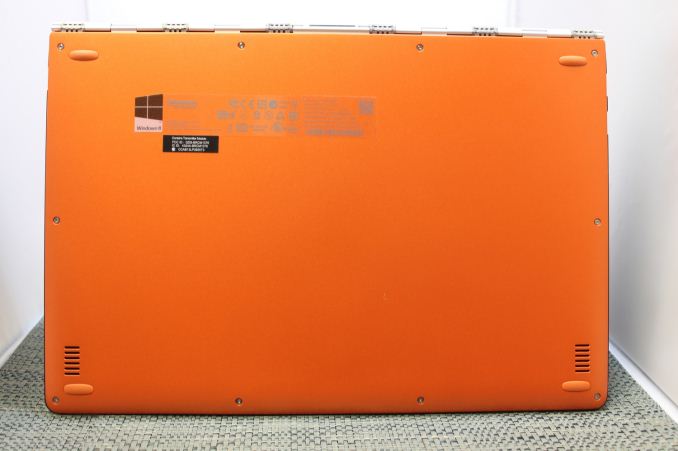


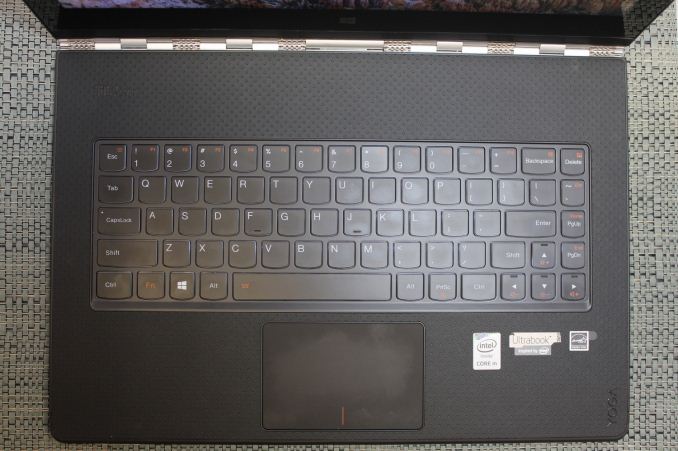
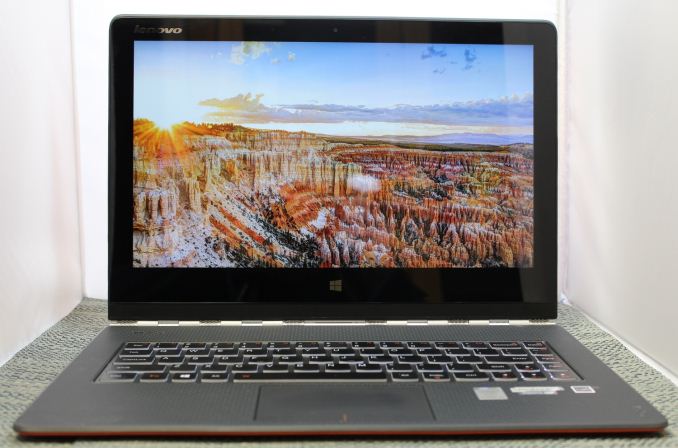

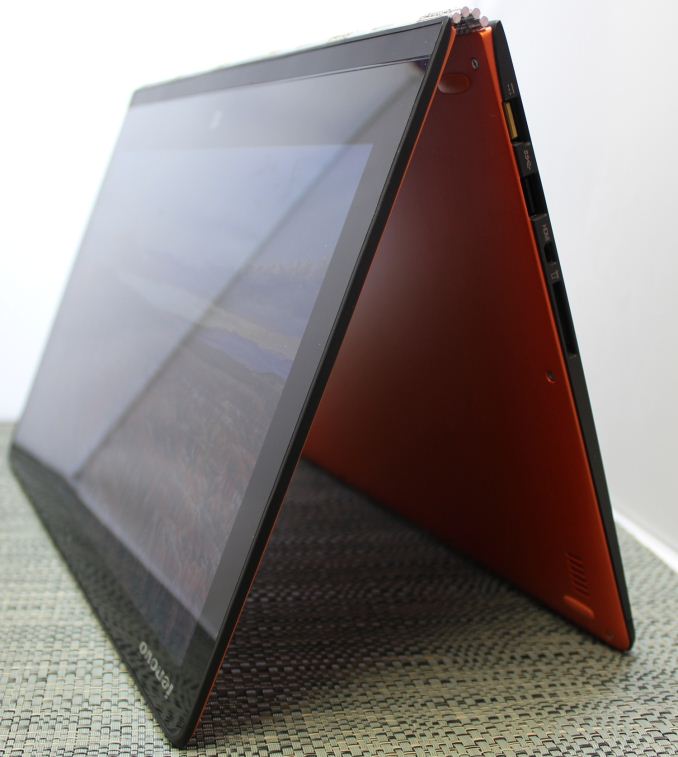
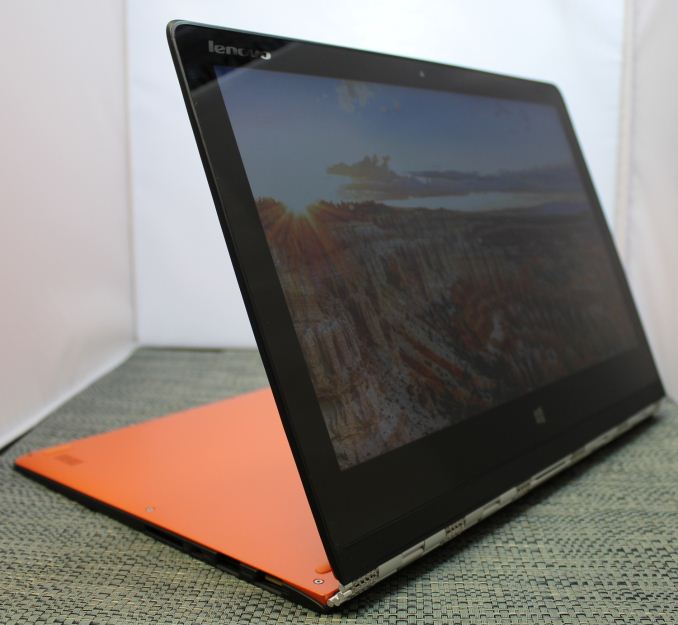








113 Comments
View All Comments
Brett Howse - Friday, March 13, 2015 - link
Sorry corrected the TDP info. We can debate about whether it is an Atom or Celeron, but it's really an Atom rebadged.jhoff80 - Friday, March 13, 2015 - link
I think you missed one. "The 5 watt Atom core in the HP Stream is sorely outclassed by the 4.5 watt Core M."kepstin - Friday, March 13, 2015 - link
Not sure what you're saying here... Bay Trail is the latest evolution of Intel's Atom series of processor core designs. While they're not using the Atom brand for it any more, that's still pretty much what it is.azazel1024 - Friday, March 13, 2015 - link
But the point is, it isn't the atom brand. It is the same architecture, but compared to the actual TABLET chips, in some ways it is worse. You have higher TDP, but the CPU is actually worse in a lot of ways, especially multithreaded tests. You've got 2 cores at up to 2.58GHz, where as the top end Atom Bay Trail chips you have 4 cores at up to 2.39GHz. I can attest in long work loads in passively cooled tablets, the z3775 doesn't really seem to throttle...so you have potentially close to a doubling of performance in highly threaded workloads for something like the z3775 compared to the N2840...which makes the whole CPU performance inbalance between "Atom" and "Broadwell M" a heck of a lot less than these tests make it out to be.Oh...there still is, but in highly threaded work loads the inbalance isn't all that much.
On the GPU side of things...well N2840 or z3775 (or other Atom chip), Broadwell M still crushes it.
It'll be interesting to see how the top end Atom Cherry Trail chips stack up. Assuming ZERO IPC improvements (and I assume there will be at least a little), it clocks in ~200MHz faster than Bay Trail and 4x the EUs (Intel was claiming top clocks of 2.6GHz and 16EU for the top end Cherry Trail tablet chips). The current pre-release Intel claims of ~100% faster GPU with no CPU claims right now.
Still makes Cherry Trail a fair amount slower on the GPU side of things, but on the CPU side...that puts it spitting distance with Broadwell M for multithreaded and if there are modest IPC improvements it might actually actually be FASTER in some multithreaded workloads.
extide - Friday, March 13, 2015 - link
It's not hard to imagine a quad core beating a dual core in multi threaded... Remember though, that in normal use, the feeling of it being fast or slow is all about single threaded speed.Also, don't get all confused with the brand names. There are 2 cores, the Atom core and the 'Core' big core -- it doesnt matter whatever brand name they use it is still either Intel's big core or little core.
fokka - Friday, March 13, 2015 - link
i think you are reading too much into the branding. it's still atom, which still means somewhat poor single threading, poor graphics, but quite ok multi threading, since there often are four cores instead of the two cores you get in all of intels other sub-35w mobile parts.i think intel doesn't do itself a favour spreading the celeron and pentium brands to the atom architecture, but here we have it, let's not make it any worse.
Solandri - Friday, March 13, 2015 - link
Intel's marketing division is just trying to confuse people by extending the Celeron and Pentium names to CPUs with the Silvermont architecture, so they can sell computers with cheaper parts for more money.Most people use the term "Atom" to refer to Intel's (current) Silvermont architecture used in Atom, and now some Celeron and Pentium models. As opposed to Intel's Haswell cores (used in Haswell and Broadwell) used in their i3/i5/i7, as well as some of the Celeron and Pentium models.
Since historically the Celeron name was only given to the upper tier architecture (Haswell, Sandy Bridge, Nehalem), it's more accurate to call the N2840 an Atom than a Celeron. Calling the N2840 a Celeron is kinda like calling the 4-cylinder Mustang a Mustang. The performance just isn't there to back up the name.
mkozakewich - Saturday, March 14, 2015 - link
Doesn't "Mustang" mean performance, though? If you get a Celeron computer, you're expecting something cheap and just fast enough to use for basic tasks.extide - Friday, March 13, 2015 - link
...Which means it's an Atom.jabber - Friday, March 13, 2015 - link
First thing I'd do if that was mine? Get rid of those awful stickers.Like those dumb car parts shopping lists muppets stick on their mom's Civic.